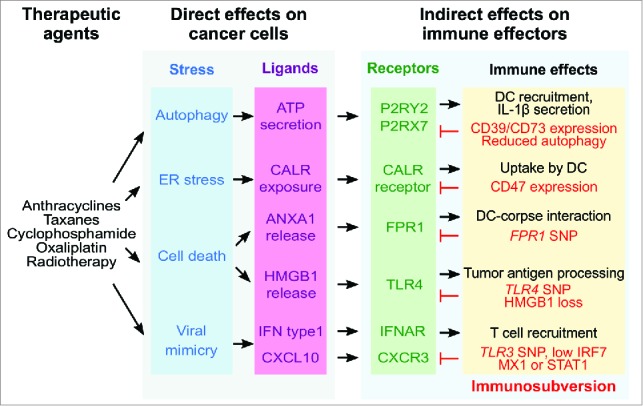Figure 1.

Pattern recognition receptors in the anticancer immune response elicited by immunogenic chemotherapy. Immunogenic cell death inducers act on cancer cells to stimulate a series of stress and death pathways including the toll-like receptor-3 (TLR3)-dependent induction of a type 1 interferon response. In this context, TLR3 is acting at the level of the malignant cells. Ligands released from stressed/dying malignant cells or exposed on their surface then add on a series of receptors on the surface of DC and their precursors, thus stimulating a cascade of events that is indispensable for stimulating an anticancer immune response. For example, annexin A1 (ANXA1) liberated from malignant cells can stimulate formyl peptide receptor-1 (FPR1) on DC to stimulate their positioning close to, and interaction with, dead cancer cells. A series of aberrations (labeled in red) has been shown to negatively affect breast cancer patients, likely because they compromise natural or therapy-induced immunosurveillance. Abbreviations: ANXA1, annexin A1; CALR, calreticulin; CXCL10, chemokine (C-X-C motif) ligand 10; CXCR3, chemokine (C-X-C motif) receptor 3; DC, dendritic cell; ER, endoplasmic reticulum; FPR1, formyl peptide receptor 1; HMGB1, high mobility group box 1; IFN, interferon; IFNAR, type 1 interferon receptor; IL, interleukin; IRF7, interferon regulatory factor 7; MX1, MX dynamin-like GTPase 1; P2RX7, purinergic receptor P2X, ligand-gated ion channel, 7; P2RY2, purinergic receptor P2Y, G-protein coupled, 2; SNP, single nucleotide polymorphism; STAT1, signal transducer and activator of transcription 1; TLR, toll like receptor.
